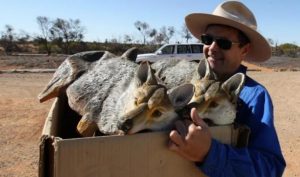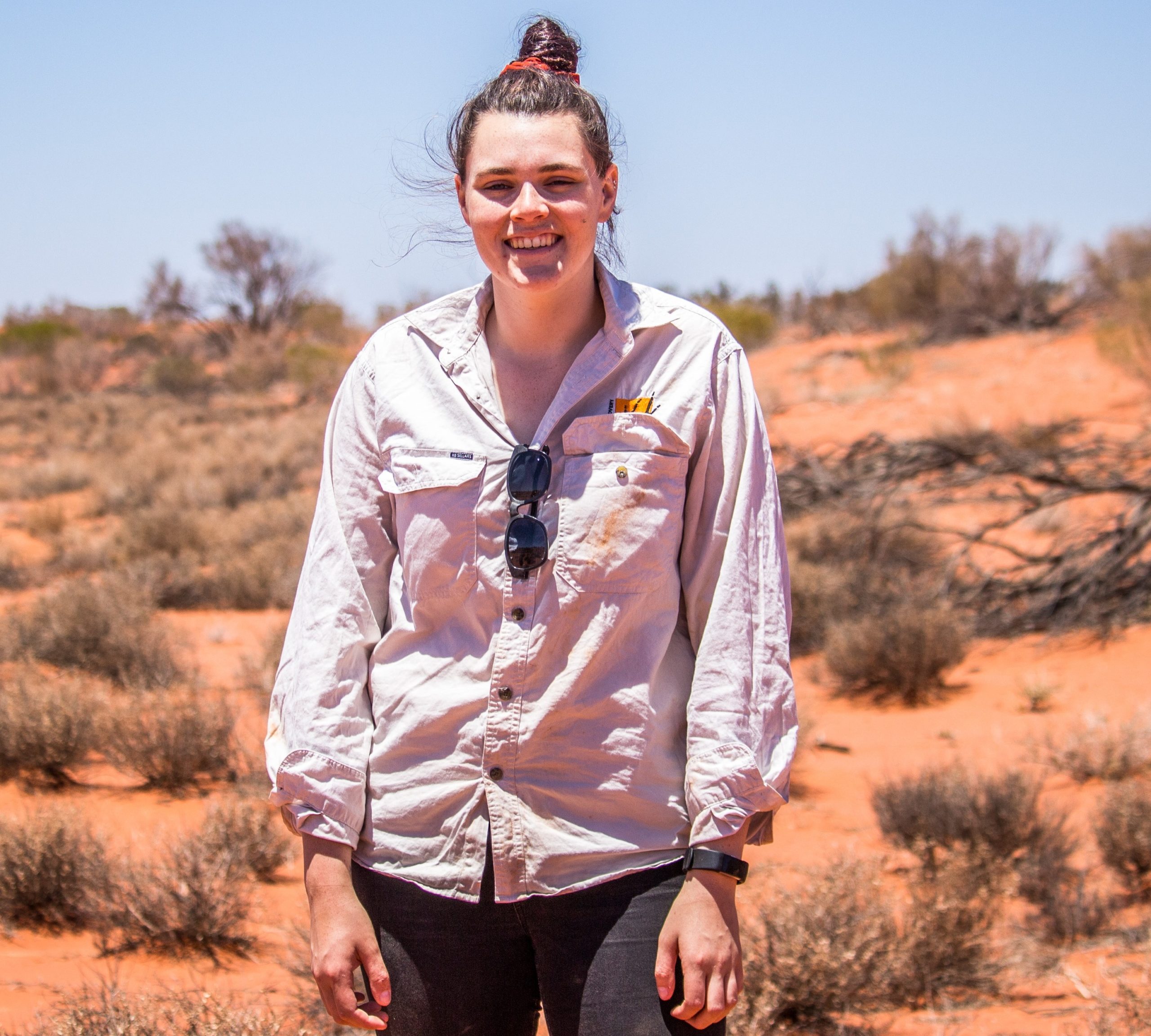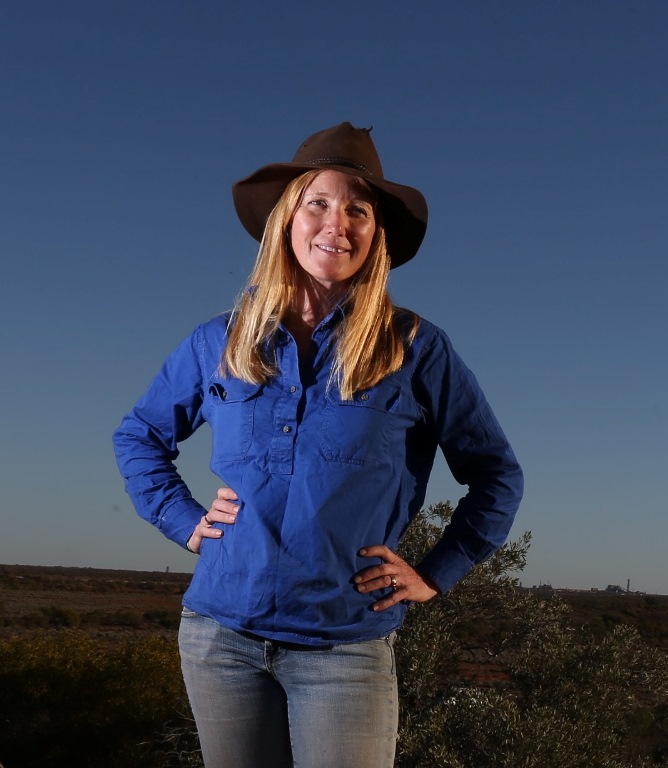Australia’s native animals did not evolve with cats and foxes. As a result, they don’t recognise cats and foxes as a threat, or behave in the ways that they need to in order to avoid becoming dinner. Arid Recovery, in collaboration with the University of New South Wales and University of California, Los Angeles, is seeking to tackle this problem of prey naivety.

The Problem
Many of Australia’s native mammal populations have been decimated by the presence of introduced predators. Part of the reason for this devastation is that our native animals are “naïve” to the threat of feral cats and foxes. They don’t show an ability to recognize, avoid, or escape from these predators and quickly become an easy meal.
This prey naivety is thought to have two causes; a lack of individual experience and a lack of coevolution between predators and prey. Many conservation projects protect threatened species through the exclusion of introduced predators, which may exacerbate the naivety of the threatened species and make them harder to reintroduce back into predator-occupied landscapes.
It’s not just feral cats and foxes that native species can be naïve to; many generations of living in a predator-free environment can also lead to the loss of appropriate responses to native predators.

Early Work
Arid Recovery began investigating prey naivety in 2005, with research showing for the first time that naïve, wild bilbies can be trained to respond to predator scents. Naïve bilbies were “trained” by being exposed to feral cat scents during a scary encounter with a fake cat. Other bilbies were included in a control group that were not exposed to cat scent. Both groups were then released and radio-tracked to burrows. When the burrows were disturbed and laced with feral cat scent, trained bilbies moved to new burrows, whilst untrained bilbies tended to return back to the same burrow each night –a poor response if feral cats had actually been snooping around.
The bilbies were then released outside of the reserve, where feral cats were present, to test if there was a difference in survival rates. Both trained and untrained bilbies showed very high post-release survival, with only one trained and one untrained bilby dying in the first six months, meaning no statistically-significant comparisons could be made.
In September 2008, 66 burrowing bettongs were translocated from the feral-free Main Exclosure to the Red Lake Expansion, which contained feral cats. Exact numbers of cats were unknown but the population was continually estimated through track counts. This bettong population continued to survive for three years until a single fox gained access to the Red Lake Expansion between December 2011 and February 2012. The bettong population went extinct in the paddock by March 2013. Additionally, over this time period several attempts to re-establish naïve burrowing bettongs and bilbies into predator-controlled areas outside of the Arid Recovery Reserve failed, in no small part due to the natives’ continued naivety to feral predators.
The Tackling Prey Naivety Project
In 2014, researchers from Arid Recovery, the University of New South Wales and the University of California began collaborating to find a solution to the vexing problem of prey naivety. Together, they published a peer-reviewed paper about the merits of using natural selection to tackle the issue.
They examined the history of reintroduction programs (which have largely focused on controlling or eradicating predators, rather than improving the anti-predator responses of prey), discussed why simulating encounters with predators in captivity is unlikely to be an effective solution, and instead pointed to in-situ predator exposure between wild predator and prey populations, as a realistic, potentially-useful and ethically justifiable form of predator avoidance training.
From this, the Tackling Prey Naivety Project was born and established at Arid Recovery, funded by the Australian Research Council. The project uses a number of the reserve’s paddocks for its research, including the Main Exclosure, First Expansion, Red Lake Expansion and Dingo Paddock.
The Main Exclosure acted as a source population for burrowing bettong and bilby translocations. Both species had been present in the 14km 2 feral-free exclosure for ~15 years, with no exposure to any mammalian predators. Wedge-tailed Eagles had been present, but likely to be of low risk to both species as they are nocturnal, whilst the eagle is diurnal.
From the Main Exclosure, 352 burrowing bettongs (23 radio-collared) were translocated to the 26km 2 Red Lake Expansion, which contained one de-sexed feral cat, whilst 10 were translocated, with radio-collars, to the 8km 2 feral-free First Expansion, to act as a procedural control. 47 bilbies were also moved from the Main Exclosure to the Red Lake Expansion.
Between June-August 2015, five additional de-sexed cats were added to the Red Lake Expansion, bringing the total cat density to 0.19/km2, which is at the lower end of the range of feral cat densities reported in Australia. After October 2016, several additional feral cats were added to the Red Lake Expansion and began breeding. Their population was closely monitored through track transects and camera trap arrays.
By April 2017, both the bettong and bilby populations had greatly increased. The bettong population grew to an estimated 858 individuals, and nearly 80% of captured females had pouch young. Bilby activity on camera traps increased more than tenfold between 2015 and 2017.
Most excitingly, after only 18 months, the cat-exposed bettongs in Red Lake Expansion had changed their behaviour; they were warier than the bettongs that were translocated into the feral-free First Expansion. Red Lake bettongs had greater flight-initiation distances (see insert box below) and approached feeding stations more slowly than bettongs in the First Expansion. Red Lake bettongs also became more docile in traps over time, whilst the First Expansion bettongs did not. This may indicate that the Red Lake bettongs are exhibiting better hiding behaviour; analysing situations more cautiously and reducing their likelihood of being detected by a predator.
Effects of deep evolutionary history
The Tackling Prey Naivety Project team have also investigated how deep evolutionary history affects predator awareness behaviours through a range of experiments. All the experiments described below used rigorous methods not described here, see the papers for more information.
Using plastic models, they have shown that bettongs have better behavioural responses to dingo/dog shapes than fox shapes, despite having never encountered either predator in their lifetime. This fits the idea that deep evolutionary history plays an important role in predator discrimination (bettongs have evolved for thousands of years alongside dingoes and thylacines, but never coexisted with foxes). The same study also showed that naïve rabbits have better responses to foxes than the dingo/dog shape, which makes sense – rabbits have evolved for longer alongside foxes than dogs.

Cat-exposed bettongs in the Red Lake Expansion have also been shown to respond better to predator scents than naïve bettongs in the First Expansion – they approach cat and Tasmanian devil scents more slowly and cautiously. Naïve bettongs don’t respond to cat or Tasmanian devil scent, indicating that they don’t recognise new predators and have lost the ability to recognise a predator that they share very deep evolutionary history with – the only surviving burrowing bettongs and Tasmanian devils were separated over 8,000 years ago (when bettong refuge islands separated from the Australian mainland).
Bilbies also appear to be better at responding to animals which they share evolutionary history with. They have lived for over 3,000 years with dingoes, but only 200 years with cats. When dog faeces were placed outside their burrows, they were much warier than when cat faeces were placed outside. With dog scat present, they spent more time only partially-emerged from their burrows, with at most head and shoulders out, as opposed to being fully-emerged and standing on four-or two feet outside.
The future
With the exception of the Main Exclosure, the predator-free paddocks of Arid Recovery are now also home to a population of native predators; western quolls. Quoll presence may help to reduce prey naivety for native animals in the First, Second and Northern Expansions, and this may lead to better outcomes for future reintroductions.
There are encouraging early signs from this research that some vulnerable native animals can learn to recognise and adapt behaviours to novel predators. But this is a long game and there is more work to be done before animals like bettongs can retake the vast open landscapes of the outback.
Arid Recovery’s published research on prey naivety:
- Blumstein, D. T., Letnic, M., & Moseby, K. (2019). In situ predator conditioning of naive prey prior to reintroduction. Philosophical Transactions B: Biological Sciences. Available here
- West, R., Blumstein, D., Letnic, M., & Moseby, K. (2018). Searching for an effective pre-release screening tool for translocations: can trap temperament predict behaviour and survival in the wild? Biodiversity and Conservation 28: 229-243. Available here
- Moseby, K.E., Blumstein, D., Letnic, M. and West, R. (2018). Choice or Opportunity? Are post-release social groupings influenced by familiarity or reintroduction protocols? Oryx. Available here
- Moseby, K., Letnic, M. Blumstein, D. and West, R. (2018). Designer Prey: Can controlled predation accelerate selection for anti-predator traits in naïve populations? Biological Conservation 217, 213-221. Available here.
- Saxon-Mills, E.C., Moseby, K., Blumstein, D.T. and Letnic, M. (2018). Prey naïvetè and the anti-predator responses of a vulnerable marsupial to known and novel predators. Behavioral Ecology and Sociobiology, 72(151). Available here
- Steindler, L.A., Blumstein, D.T., West, R., Moseby, K.E. and Letnic, M. (2018). Discrimination of introduced predators by ontogenetically naïve prey scales with duration of shared evolutionary history. Animal Behaviour, 137: 133-139. Available here
- Moseby, K.E., Letnic, M., Blumstein, D.T. and West, R. (2018b). Understanding predator densities for successful co-existence of alien predators and threatened prey. Austral Ecology, https://doi.org/10.1111/aec.12697.
Available here - West, R., Letnic, M., Blumstein, D.T. and Moseby, K.E. (2017). Predator exposure improves anti-predator responses in a threatened mammal. Journal of Applied Ecology, https://doi.org/10.1111/1365-2664.12947. Available here
- Atkins, R., Blumstein, D.T., Moseby, K.E., West, R., Hyatt, M. and Letnic, M. (2016). Deep evolutionary experience explains mammalian responses to predators. Behavioral Ecology and Sociobiology, 70(10): 1755-1763. Available here
- Moseby, K.E., Blumstein, D.T. and Letnic, M. (2015). Harnessing natural selection to tackle the problem of prey naïvete. Evolutionary Applications, 9(2): https://doi.org/10.1111/eva.12332. Available here
- Moseby, K.E., Cameron, A. and Crisp, H. (2012). Can predator avoidance training improve reintroduction outcomes for the greater bilby in arid Australia? Animal Behaviour, 83: 1011-1021. Available here


















